overheating CHEVROLET BLAZER 1996 2.G Owners Manual
[x] Cancel search | Manufacturer: CHEVROLET, Model Year: 1996, Model line: BLAZER, Model: CHEVROLET BLAZER 1996 2.GPages: 392, PDF Size: 20.35 MB
Page 127 of 392
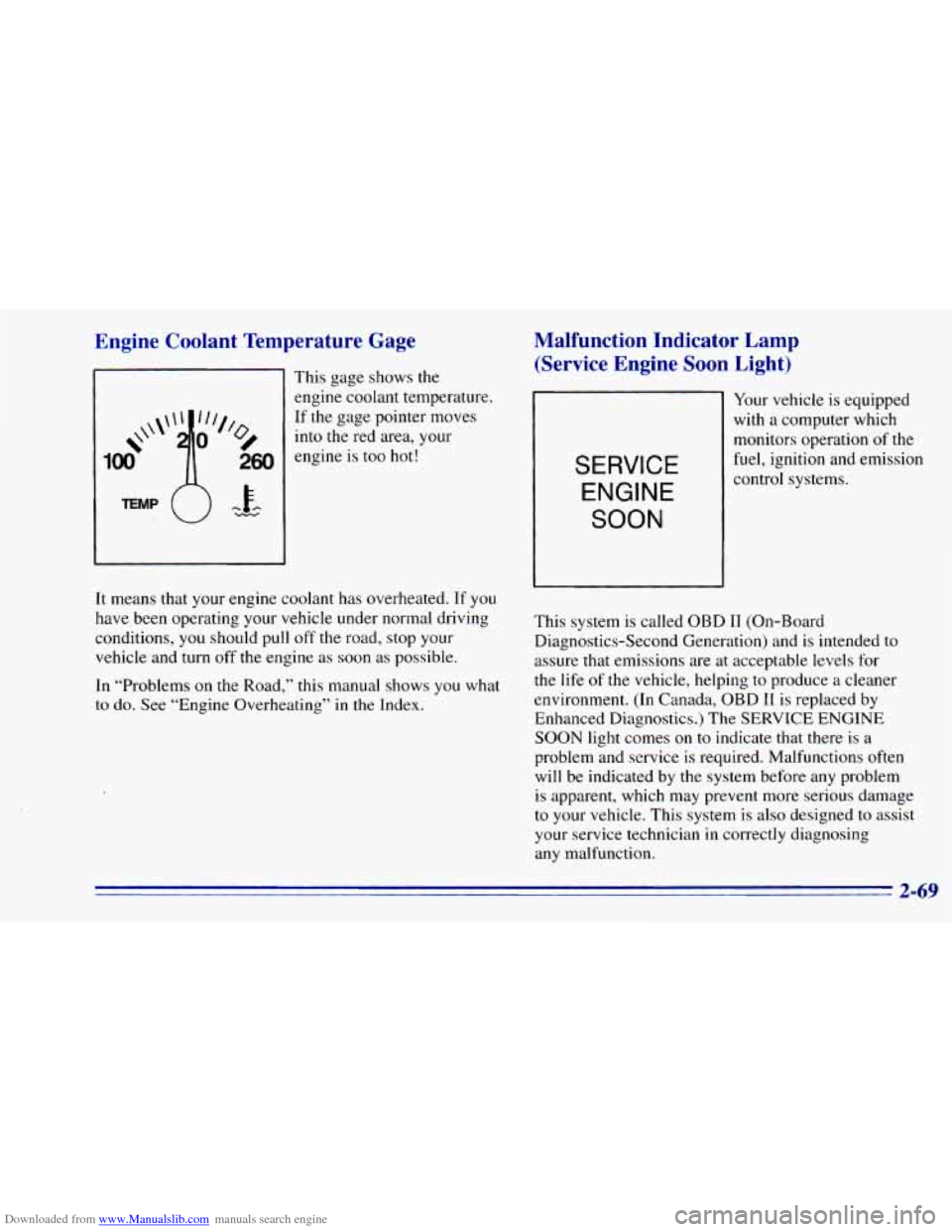
Downloaded from www.Manualslib.com manuals search engine Engine Coolant Temperature Gage
This gage shows the
engine coolant temperature.
If the gage pointer moves
into the red area, your
engine is too hot!
Malfunction Indicator Lamp
(Service Engine Soon Light)
SERVICE
ENGINE
SOON
Your vehicle is equipped
with a computer which
monitors operation
of the
fuel, ignition and emission
control systems.
It means that your engine coolant has overheated. If
you
have been operating your vehicle under normal driving
conditions,
you should pull off the road, stop your
vehicle and turn
off the engine as soon as possible.
In “Problems
on the Road,” this manual shows you what
to do. See “Engine Overheating” in the Index. This
system is called OBD I1 (On-Board
Diagnostics-Second Generation) and is intended to
assure that emissions are at acceptable levels for
the life
of the vehicle, helping to produce a cleaner
environment. (In Canada, OBD
I1 is replaced by
Enhanced Diagnostics.) The SERVICE ENGINE
SOON light comes on to indicate that there is a
problem and service is required. Malfunctions often
will be indicated by
the system before any problem
is apparent, which may prevent more serious damage
to your vehicle. This system is also designed to assist
your service technician
in correctly diagnosing
any malfunction.
2-69
Page 208 of 392
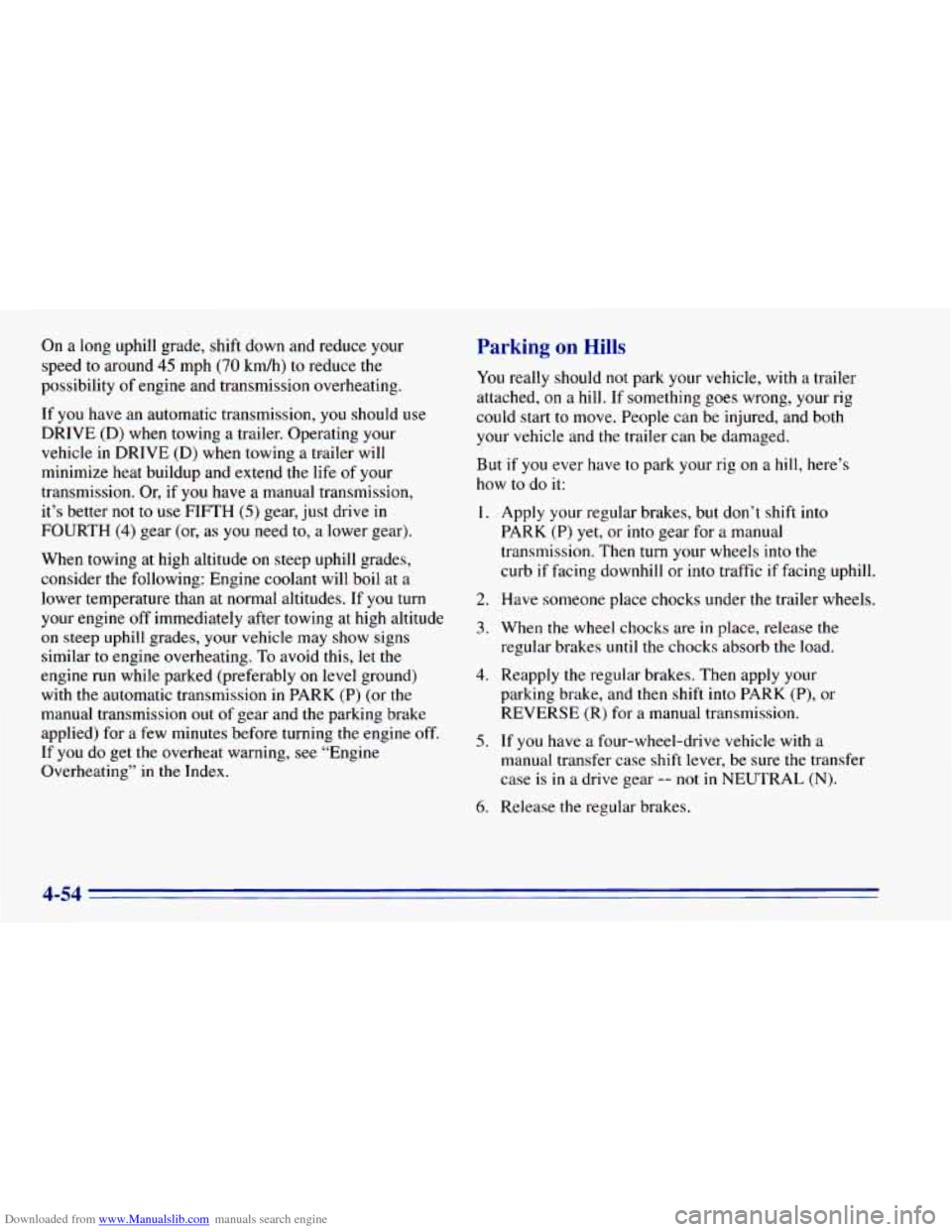
Downloaded from www.Manualslib.com manuals search engine On a long uphill grade, shift down and reduce your
speed to around
45 mph (70 kmh) to reduce the
possibility of engine and transmission overheating.
If you have
an automatic transmission, you should use
DRIVE (D) when towing
a trailer. Operating your
vehicle in DRIVE
(D) when towing a.trailer will
minimize heat buildup and extend the life of your
transmission. Or, if
you have a manual transmission,
it’s better not to use FIFTH
(5) gear, just drive in
FOURTH (4) gear (or, as you need to, a lower gear).
When towing at high altitude
on steep uphill grades,
consider the following: Engine coolant will boil at a
lower temperature than at normal altitudes. If you turn
your engine off immediately after towing at high altitude
on steep uphill grades, your vehicle may show signs
similar to engine overheating.
To avoid this, let the
engine run while parked (preferably on level ground)
with the automatic transmission in PARK
(P) (or the
manual transmission
out of gear and the parking brake
applied) for a few minutes before turning the engine off.
If
you do get the overheat warning, see “Engine
Overheating” in the Index.
Parking on Hills
You really should not park your vehicle, with a trailer
attached,
on a hill. If something goes wrong, your rig
could start to move. People can be injured, and both
your vehicle and the trailer can be damaged.
But
if you ever have to park your rig on a hill, here’s
how to
do it:
1.
2.
3.
4.
5.
6.
Apply your regular brakes, but don’t shift into
PARK
(P) yet, or into gear for a manual
transmission. Then turn your wheels into the
curb
if facing downhill or into traffic if facing uphill.
Have someone place chocks under the trailer wheels.
When the wheel chocks are
in place, release the
regular brakes
until the chocks absorb the load.
Reapply the regular brakes.
Then apply your
parking brake, and then shift into PARK (P), or
REVERSE
(R) for a manual transmission.
If
you have a four-wheel-drive vehicle with a
manual transfer case shift lever, be sure the transfer
case is
in a drive gear -- not in NEUTRAL (N).
Release the regular brakes.
4-54
Page 223 of 392
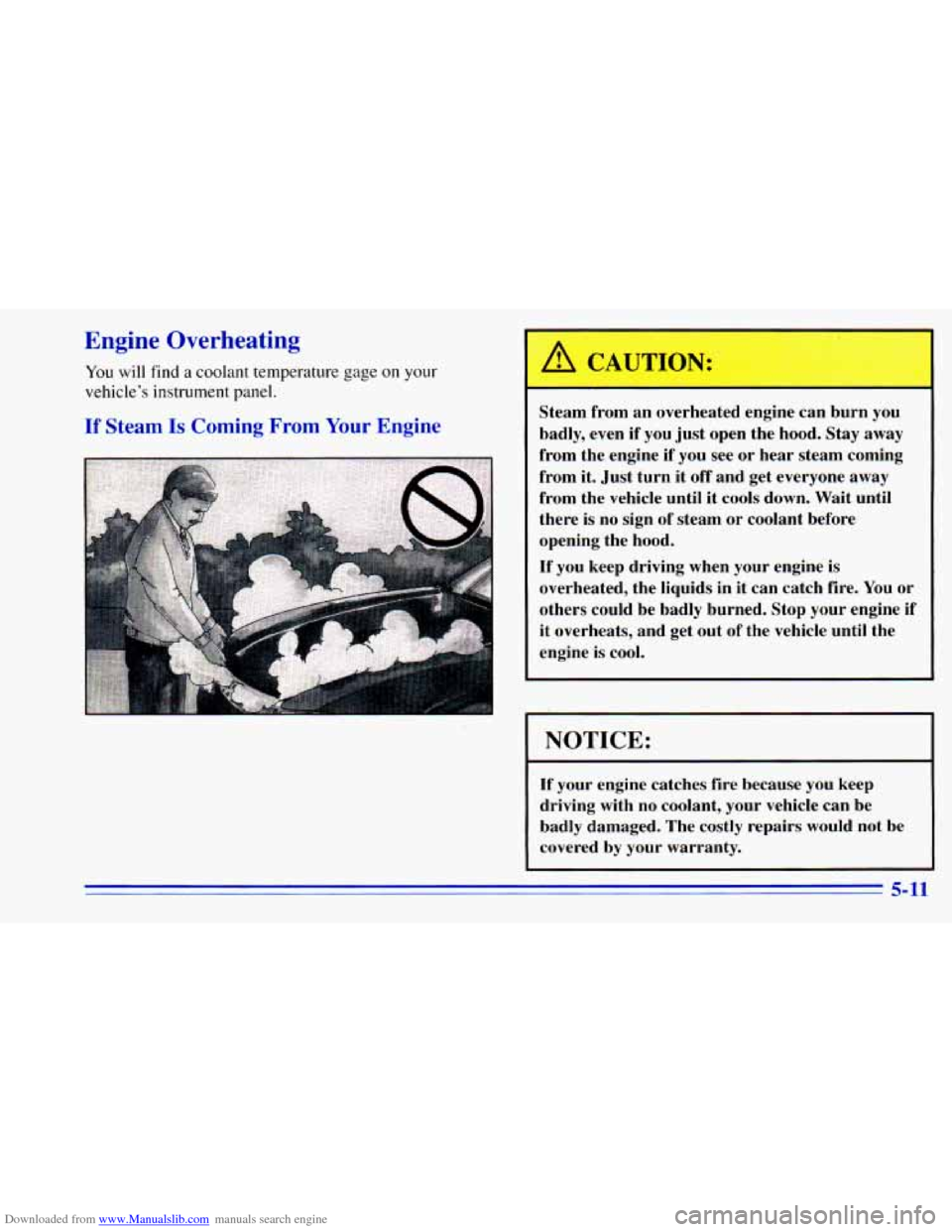
Downloaded from www.Manualslib.com manuals search engine Engine Overheating
You will find a coolant temperature gage on your
vehicle’s instrument panel.
If Steam Is Coming From Your Engine
- :/..:
Steam from an overheated engine can burn you
badly, even if you just open the hood. Stay away
from the engine if you see or hear steam coming
from it. Just turn it
off and get everyone away
from the vehicle until it cools down. Wait until
there
is no sign of steam or coolant before
opening the hood.
If you keep driving when your engine is
overheated, the liquids in it can catch fire.
You or
others could be badly burned. Stop your engine if
it overheats, and get out of the vehicle until the
engine is cool.
I NOTICE:
If your engine catches fire because you keep
driving with no coolant, your vehicle can be
badly damaged. The costly repairs would not be
covered
by your warranty.
5-11
Page 270 of 392
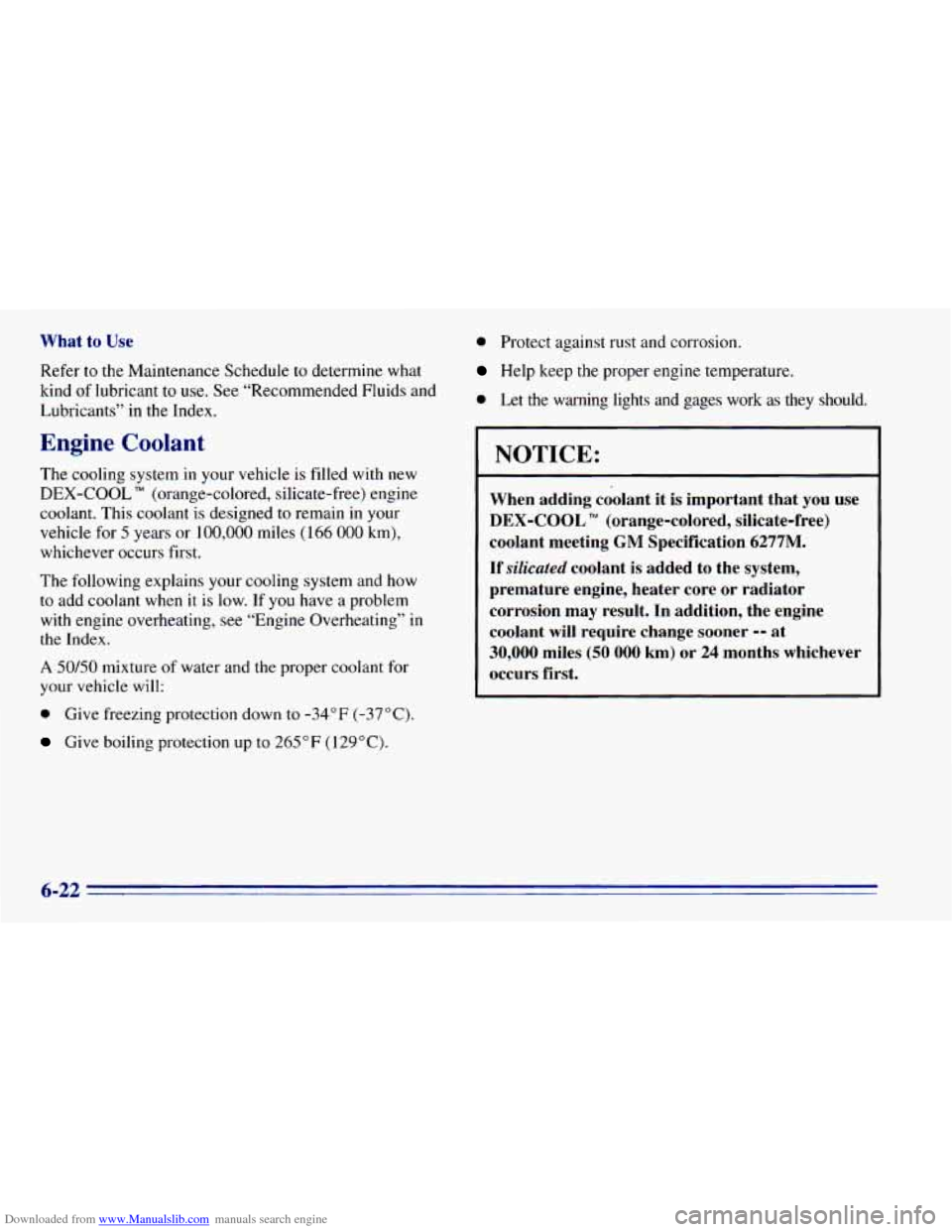
Downloaded from www.Manualslib.com manuals search engine What to Use
Refer to the Maintenance Schedule to determine what
kind of lubricant to use. See “Recommended Fluids and
Lubricants” in the Index.
Engine Coolant
The cooling system in your vehicle is filled with new
DEX-COOL TM (orange-colored, silicate-free) engine
coolant. This coolant is designed to remain
in your
vehicle for
5 years or 100,000 miles (166 000 km),
whichever occurs first.
The following explains your cooling system and how
to add coolant when
it is low. If you have a problem
with engine overheating, see “Engine Overheating” in
the Index.
A 50/50 mixture of water and the proper coolant for
your vehicle will:
0 Give freezing protection down to -34°F (-37 “C).
Give boiling protection up to 265 “F (129°C).
0 Protect against rust and corrosion.
Help keep the proper engine temperature.
0 Let the warning lights and gages work as they should.
I 1
NOTICE:
When adding coolant it is important that you use
DEX-COOL TM (orange-colored, silicate-free)
coolant meeting
GM Specification 6277M.
If silicated coolant is added to the system,
premature engine, heater core or radiator
corrosion may result. In addition, the engine coolant
will require change sooner -- at
30,000 miles (50 000 km) or 24 months whichever
occurs first.
6-22
Page 273 of 392
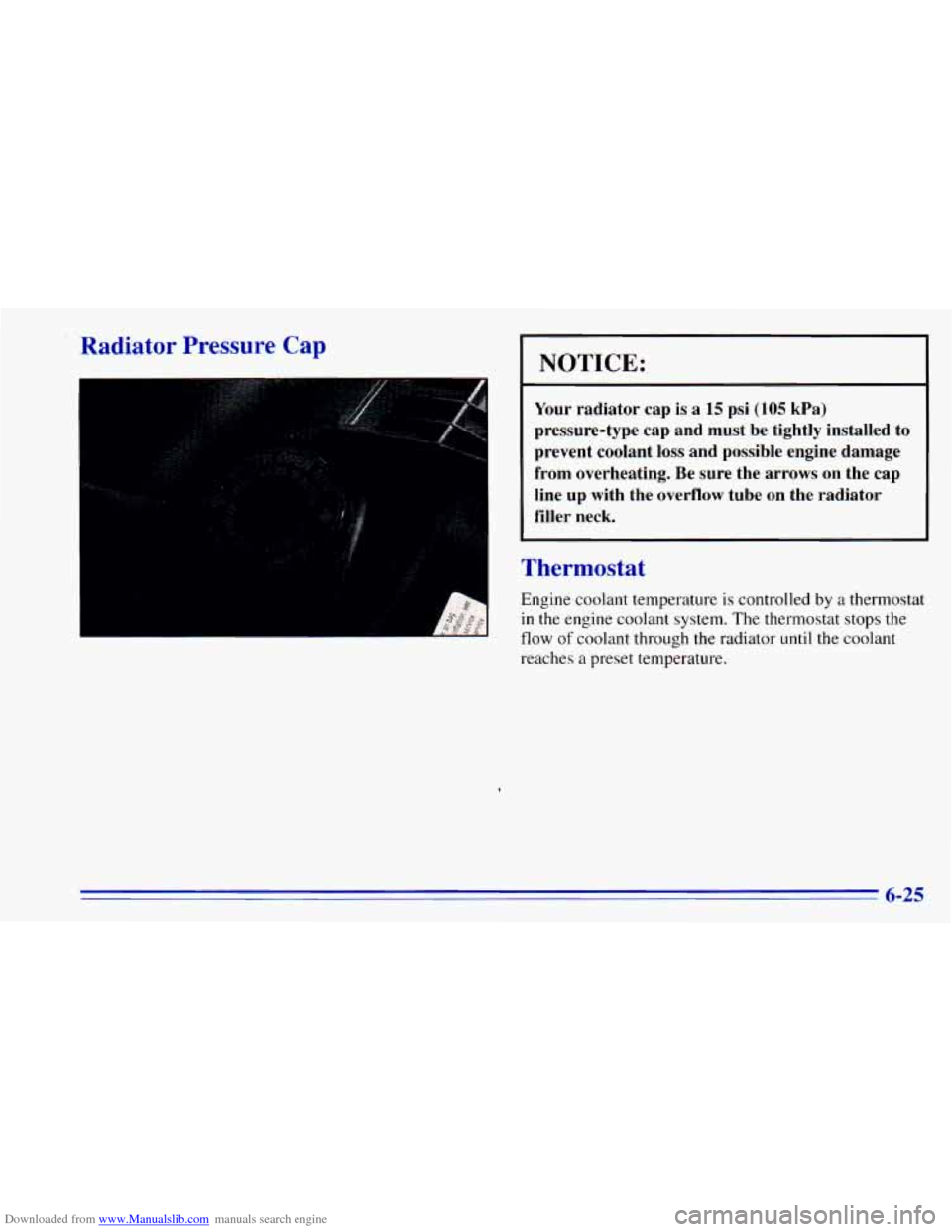
Downloaded from www.Manualslib.com manuals search engine ’ Radiator Pressure Cap
NOTICE:
Your radiator cap is a 15 psi (105 kPa)
pressure-type cap and must be tightly installed to
prevent coolant
loss and possible engine damage
from overheating. Be sure the arrows on the cap line up with the overflow tube on the radiator
filler neck.
Thermostat
Engine coolant temperature is controlled by a thermostat
in the engine coolant system. The thermostat stops the
flow of coolant through the radiator until the coolant
reaches a preset temperature.
6-25
Page 289 of 392
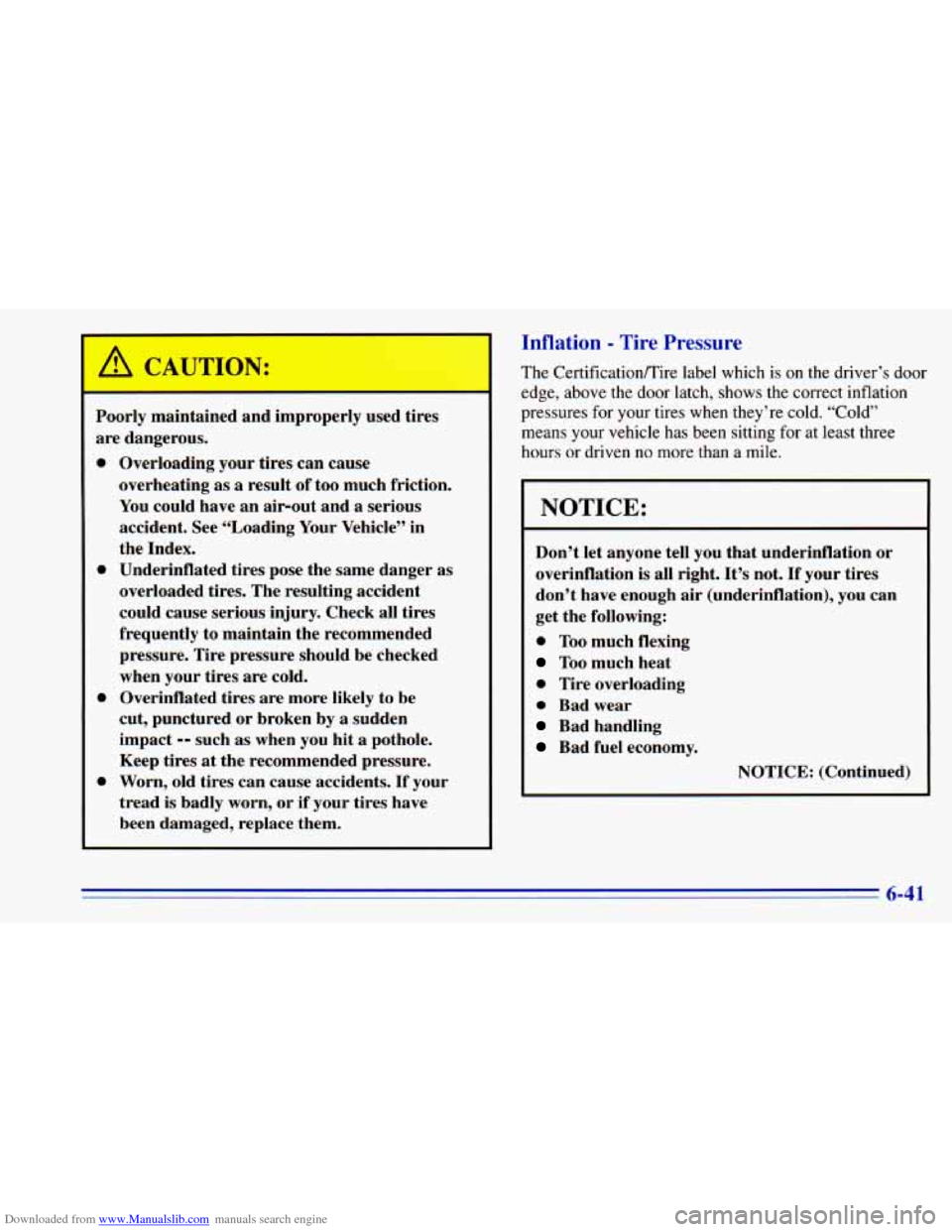
Downloaded from www.Manualslib.com manuals search engine Poorly maintained and im
are dangerous. operly
used tires
0
0
0
0
Overloading your tires can cause
overheating
as a result of too much friction.
You could have an air-out and a serious
accident. See “Loading Your Vehicle” in
the Index.
Underinflated tires pose the same danger as
overloaded tires. The resulting accident
could cause serious injury. Check all tires
frequently to maintain the recommended
pressure. Tire pressure should be checked when your tires are cold.
Overinflated tires are more likely
to be
cut, punctured or broken by a sudden
impact
-- such as when you hit a pothole.
Keep tires at the recommended pressure.
Worn, old tires can cause accidents.
If your
tread
is badly worn, or if your tires have
been damaged, replace them.
Inflation - Tire Pressure
The Certificationmire label which is on the driver’s door
edge, above the door latch, shows the correct inflation
pressures for your tires
when they’re cold. “Cold”
means your vehicle has been sitting for
at least three
hours or driven
no more than a mile.
NOTICE:
Don’t let anyone tell you that underinflation or
overinflation is all right. It’s not.
If your tires
don’t have enough air (underinflation), you can
get the following:
0 Too much flexing
Too much heat
0 Tire overloading
0 Bad wear
Bad handling
Bad fuel economy.
NOTICE: (Continued)
6-41
Page 383 of 392
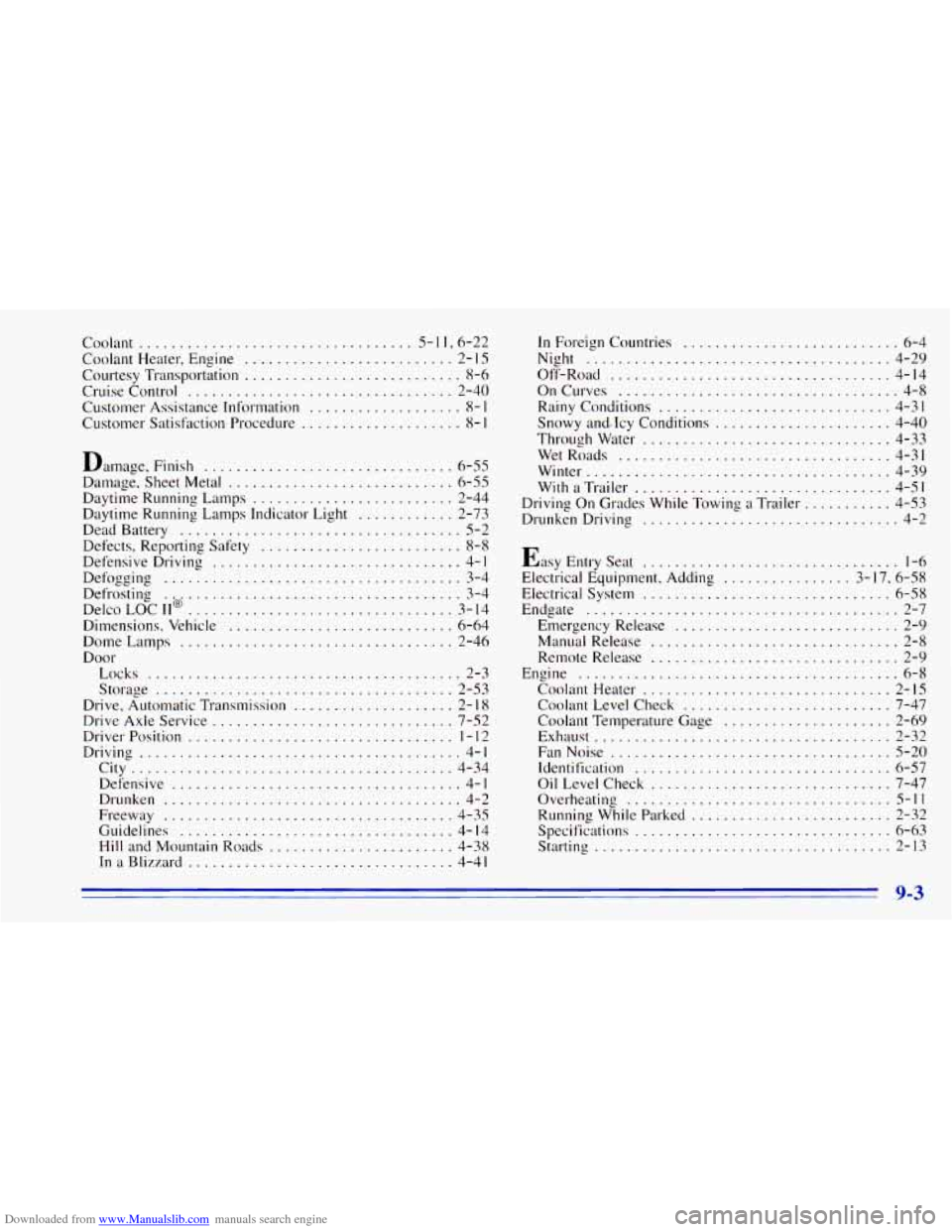
Downloaded from www.Manualslib.com manuals search engine Coolant .............................. 5- 1 1. 6-22
Courtesy Transportation
........................... 8-6
Cruise Control ................................. 2-40
Customer Assistance Information
................... 8- 1
Customer Satisfaction Procedure .................. 8- 1
Coolant Heater. Engine .......................... 2- I5
Damage. Finish ............................... 6-55
Damage. Sheet Metal
............................ 6-55
Daytime Running Lamps
......................... 2-44
Daytime Running Lamps Indicator Light
............ 2-73
Dead Battery
................................... 5-2
Defensive Driving
............................... 4- I
Defogging ..................................... 3-4
Defrosting
................................ 3-4
DelcoLOCII
................................. 3-14
Dimensions. Vehicle
............................ 6-64
Dome Lamps
............ .................. 2-46
Door Defects. Reporting Safety
......................... 8-8
@ **
Locks ....................................... 2-3
Storage
..................................... 2-53
Drive. Automatic Transmission
.................... 2- I8
Drive Axle Service .............................. 7-52
Driver Position
................................. I - 12
Driving ........................................ 4-1
City
........................................ 4-34
Defensive
.................................... 4-1
Drunken
..................................... 4-2
Freeway
.................................... 4-35
Guidelines
.................................. 4- I4
Hill and Mountain Roads ....................... 4-38
InaBlizzard
................................. 4-41
In Foreign Countries ........................... 6-4
Night
...................................... 4-29
Off-Road
................................... 4-14
OnCurves
................................... 4-8
Rainy Conditions
............................. 4-31
Snowy and. Icy Conditions
...................... 4-40
Throughwater
............................... 4-33
Wet Roads
.................................. 4-31
Winter
...................................... 4-39
With a Trailer
................................ 4-51
Driving On Grades While Towing a Trailer
........... 4-53
Drunken Driving
................................ 4-2
Easy Entry Seat
................................ 1-6
Electrical Equipment. Adding
................ 3- 17. 6-58
Electrical System
............................... 6-58
Endgate
....................................... 2-7
Emergency Release
............................ 2-9
ManualRelease
............................... 2-8
Remote Release ............................... 2-9
Coolant Heater
............................... 2-15
Coolant Level Check
.......................... 7-47
Coolant Temperature Gage
..................... 2-69
FanNoise
................................... 5-20
Identification
................................ 6-57
OilLevelCheck
.............................. 7-47
Overheating ................................. 5-11
Specifications ................................ 6-63
Engine
........................................ 6-8
Exllaust
..................................... 2-32
Running While Parked
......................... 2-32
Starting
..................................... 2-13
9-3
Page 386 of 392
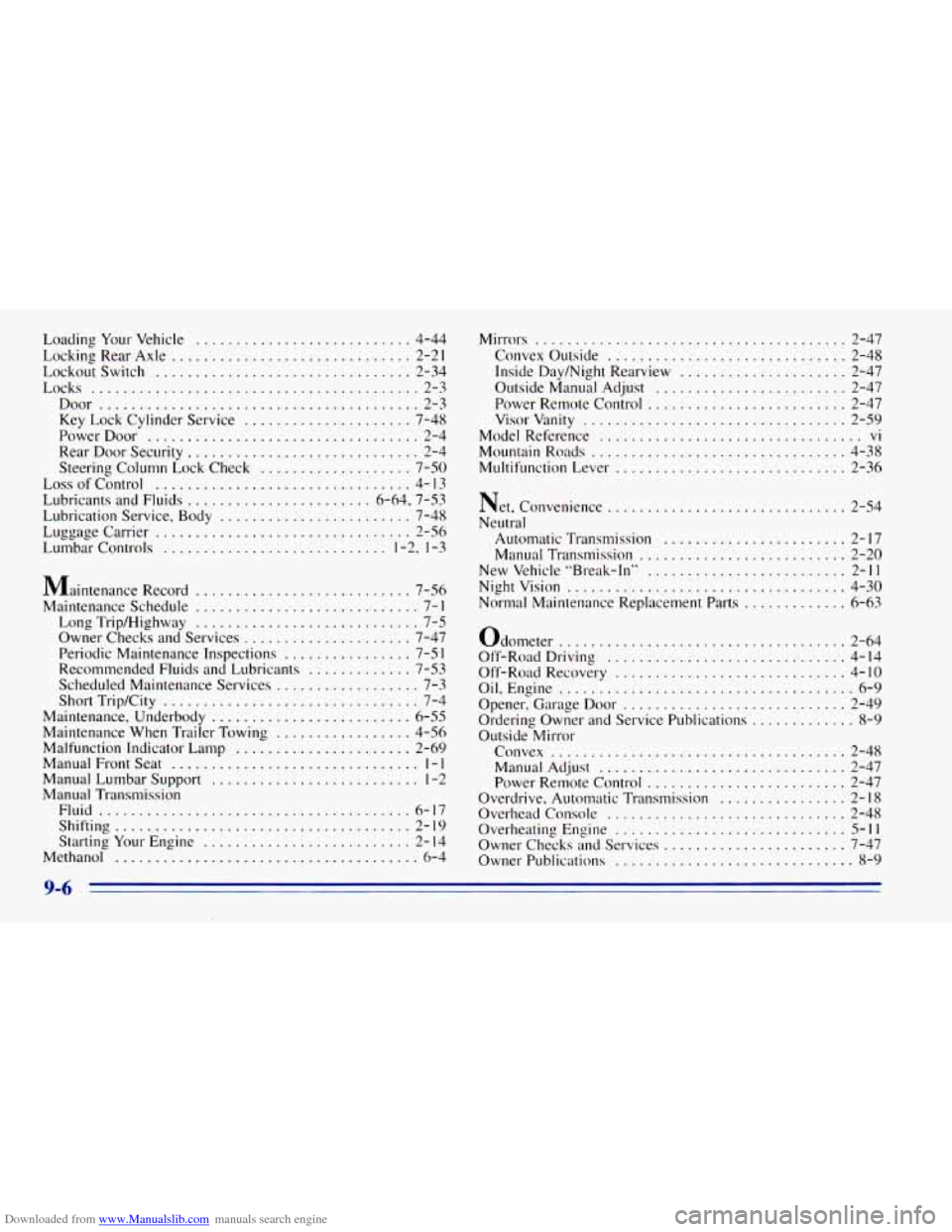
Downloaded from www.Manualslib.com manuals search engine Loading Your Vehicle ........................... 4-44
Locking Rear Axle
.............................. 2-2 1
Lockoutswitch ................................ 2-34
Locks
......................................... 2-3
Door
........................................ 2-3
Key Lock Cylinder Service
..................... 7-48
PowerDoor
.................................. 2-4
Rear Door Security
............................. 2-4
Steering Column Lock Check
................... 7-50
Loss
of Control ................................ 4- I3
Lubricants and Fluids ....................... 6.64. 7.53
Lubrication Service. Body
........................ 7-48
Luggagecarrier
................................ 2-56
Lumbar Controls
............................ 1.2 . 1-3
Maintenance Record ........................... 7-56
Maintenance Schedule
............................ 7- 1
Long Trip/Highway ............................ 7-5
Owner Checks and Services
..................... 7-47
Periodic Maintenance Inspections
................ 7-5 1
Recommended Fluids and Lubricants ............. 7-53
Scheduled Maintenance Services
.................. 7-3
Short Trip/City
................................ 7-4
Maintenance. Underbody
......................... 6-55
Maintenance When Trailer Towing ................. 4-56
Malfunction Indicator Lamp
...................... 2-69
ManualFrontSeat
............................... 1-1
Manual Lumbar Support .......................... 1-2
Manual Transmission
Fluid
..................................... 6-17
Shifting
........................... ..... 2-19
Starting Your Engine
.............. ... 2-14
Methanol
...................................... 6-4 Mirrors
....................................... 2-47
Convex Outside
.............................. 2-48
Inside Day/Night Rearview ..................... 2-47
Power Remote Control
......................... 2-47
Visorvanity
................................. 2-59
Model Reference
................................. vi
Mountain Roads ................................ 4-38
Multifunction Lever
............................. 2-36
Net. Convenience
.............................. 2-54
Neutral Automatic Transmission
....................... 2-17
Manual Transmission
.......................... 2-20
New Vehicle “Break-In”
......................... 2-11
Nightvision ................................... 4-30
Normal Maintenance Replacement Parts
............. 6-63
Outside Manual Adjust
........................ 2-47
Odometer
.................................... 2-64
Off-Road Driving
.............................. 4-14
Off-Road Recovery
............................. 4- IO
Oil. Engine ..................................... 6-9
Opener. Garage Door
............................ 2-49
Ordering Owner and Service Publications
............. 8-9
Outside Mirror Convex
..................................... 2-48
Manual
Adjust ............................... 2-47
Power Remote Control
......................... 2-47
Overdrive. Automatic Transmission
................ 2-18
Overhead Console
.............................. 2-48
Overheating Engine
............................. 5-11
Owner Checks and Services ....................... 7-47
Owner Publications
.............................. 8-9
9-6